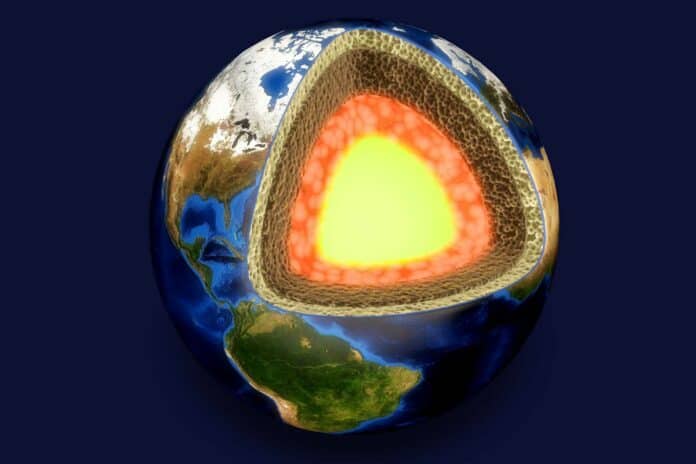The Earth’s core–mantle boundary dramatically changes materials from silicate to metal. At the same time, little is known about chemical interactions between them.
Seismologists studying the deep planet a few decades ago discovered a thin layer hardly more than a few hundred kilometers thick. Until recently, the origin of this layer, often referred to as the E prime layer, was unknown.
A team of researchers, including scientists from Arizona State University—Dan Shim, Taehyun Kim, and Joseph O’Rourke from the School of Earth and Space Exploration—has performed high-temperature and -pressure laser-heated diamond-anvil cell experiments. They used advanced experimental techniques at the Advanced Photon Source of Argonne National Lab and PETRA III of Deutsches Elektronen-Synchrotron in Germany to replicate the extreme conditions at the core-mantle boundary. They found that subducted water chemically reacts with core materials.
This reaction forms a hydrogen-rich, silicon-depleted layer, altering the topmost outer core region into a film-like structure. Additionally, the reaction generates silica crystals that rise and integrate into the mantle-temperature conditions relevant to the Earth’s core–mantle boundary.
It suggests that deep within the planet, water from the Earth’s surface can seep into it, changing the metallic liquid core’s outermost region’s composition and forming a distinct thin layer. This modified liquid metallic layer is predicted to be less dense, with reduced seismic velocities.
It has long been thought there is little material exchange between the Earth’s mantle and core. However, new experiments conducted under extreme pressure tell a different scenario.
Studies show that subducted, or falling, tectonic plates have carried surface water deep into the Earth over billions of years. When this water reaches the 1,800-mile-deep core-mantle boundary, it initiates a significant chemical reaction that modifies the core structure.
Arizona State University scientist Dan Shim said, “When water reaches the core-mantle boundary, it reacts with silicon in the core, forming silica. This discovery and our previous observation of diamonds forming from water reacting with carbon in iron liquid under extreme pressure point to a far more dynamic core-mantle interaction, suggesting substantial material exchange.”
This discovery contributes to our understanding of Earth’s interior processes by pointing to a larger global water cycle than previously thought. The deep metallic core and the surface-water cycle are linked by geochemical cycles, which are significantly affected by the altered “film” of the body.
Journal Reference:
- Kim, T., O’Rourke, J.G., Lee, J., et al. A hydrogen-enriched layer in the topmost outer core sourced from deeply subducted water. Nat. Geosci. (2023). DOI: 10.1038/s41561-023-01324-x
